The Ultimate Guide – Poker Fortress
You are for a treat today. I have put together the most extensive guide on playing weak Ax hands. Ace-rag is a hand that gets misplayed the most from novice players, preflop and post-flop. Most money gets lost because players overvalue their top pair, no kicker (TPNK) hands. Players sometimes feel committed with their TPNK and invest way too much money into the pot.
Since all ace-rags amount to close to 10% of the deck, it’s very important to know when and how to play them. Playing ace-rag can be very tricky, so we will discuss some strategies in the next chapters. Hopefully, that will stop you from burning money in the long run.
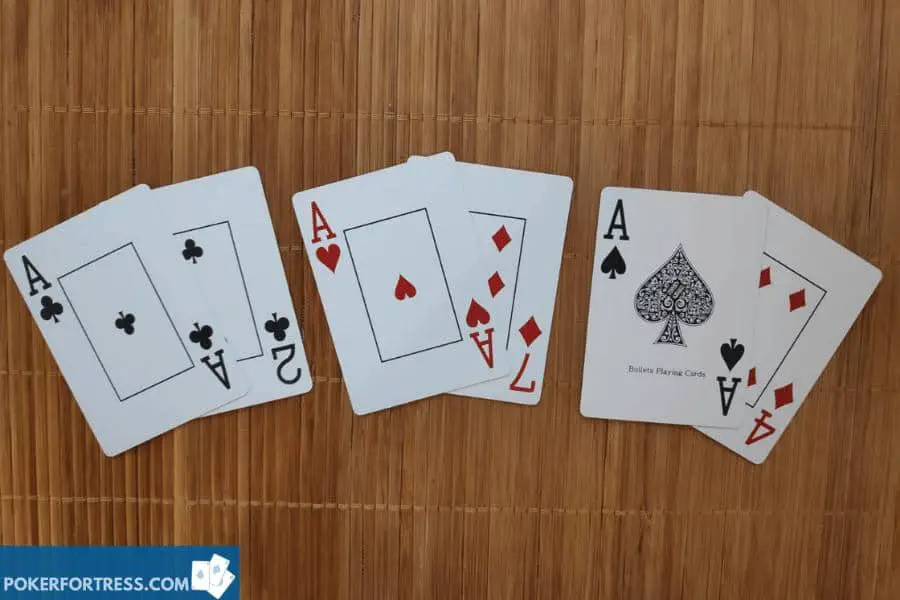 Ace rag are all hole cards consisting of an ace and 9 or a lower card.
Ace rag are all hole cards consisting of an ace and 9 or a lower card.
What exactly is ace-rag
Defining ace-rag can be a little tricky. Do suitedness and position influence on how bad ace is? They do actually.
A9o OTB is considered almost premium while we can dump it pretty easily UTG. A5s from MP is a standard open while off-suited combos are basically unplayable. For the sake of argument, we will define ace-rag as an ace with a kicker 9 and below.
It’s an ace with a weak kicker that cannot flop a broadway straight.
Wheel aces
Aces with a kicker between 2 and 5 are called wheel aces. The only difference between them and other rag aces is that they can flop a straight. That gives them a small overall equity advantage vs. “non-wheel” ace-rags. As you can see in table 1 A5s has 1% more equity than A7s, which is kinda counter-intuitive. I know it’s only 1%, but small things add up in poker.
Equity against A6sA7sA8sA3sA4sA5s99+,AJs+,KQs,AQo+31.84%31.99%31.91%32.44%32.78%33.09%Table 1: Equity difference between wheel Ax and non-wheel ones, that have a higher kicker.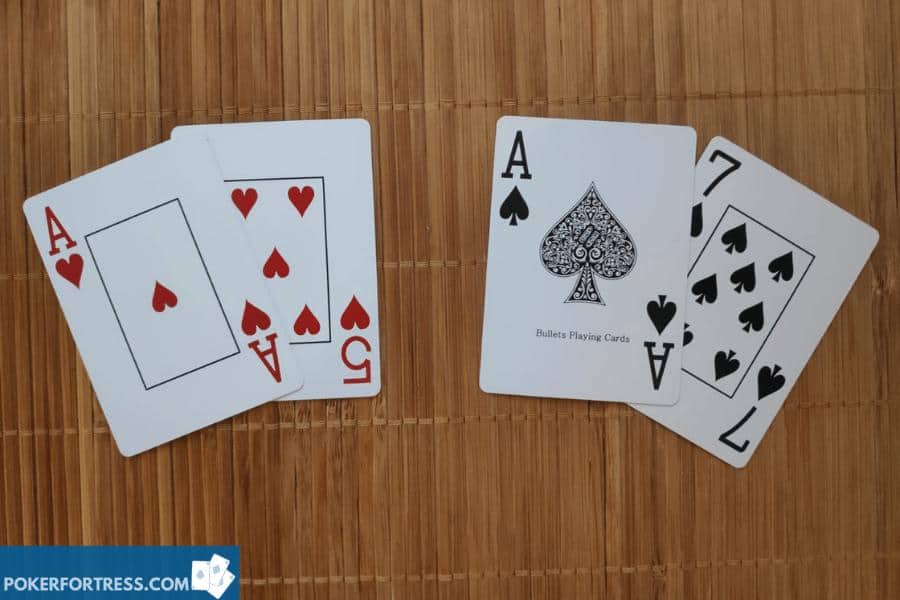 The A5 suited has the chance to hit a wheel straight and has a higher equity than the A7s in the above spot.
The A5 suited has the chance to hit a wheel straight and has a higher equity than the A7s in the above spot.
Suited vs. off-suited ace-rag
There are 128 (out of 1326) combos of ace-rags in the deck, which amounts to 9.65% of all possible starting hands. Only 32 (2.4%) combinations come in suited varieties. There are 12 combinations of each off-suite ace and 4 of its suited counterparts. As shown in table 2 there is a significant equity difference between suited and off suited combinations. When we hold a suited hand, the possibility of making a flush increases, which gives us better overall equity (4%).
vs.A5sA5o99+,AJs+,KQs,AQo+33.14%29.35%Table 2: A5s vs. A5o – difference in equity.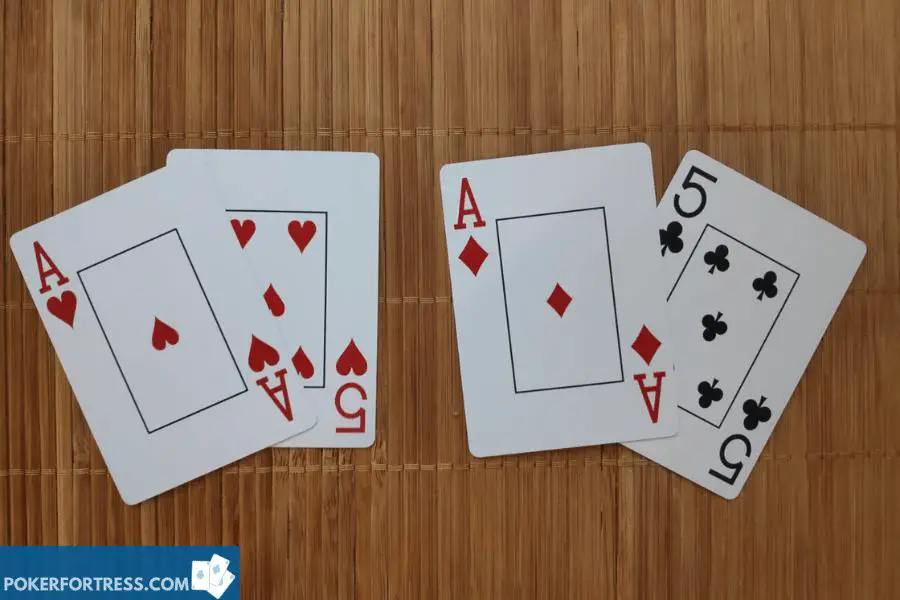 Difference i nequity between A5s and A5o is quite big.
Difference i nequity between A5s and A5o is quite big.
Fun fact: Remember in-game when it sometimes feels like you get dealt ace rag all the time. It is more likely that you’re going to get ace with a rag then any other broadway card. Take, for example, Jack rag of which there are only 80 combinations compared to 128 combos of ace rag.
Suited
The most crucial attribute of suited aces is the possibility of flopping nut flush or nut flush draw (FD). Basic poker probability tells us that we flop a flush 0.8% of the time and FD 10.09% of the time. The potential for making a big hand allows us to call and bet more liberally.
Suited aces have excellent post-flop playability, which gives them the option to play and win big pots.
Off-suited
There is 3 times more likely that you will get dealt offsuit ace then suited. Every time that you get dealt a hand, there is a 7.24% chance that you will get off suited ace-rag.
There are more off suited ace rags that there are pair combinations (96 combinations vs. 78 combinations). Imagine that!
So now that we know how common ace rag is, let’s dive right into some strategy.
Opening with an ace rag
Ace rags play mostly the role of steals in a preflop RFI (raise first in) strategy. Off suite, varieties serve mainly for late position steals, while you can open Ax suited from any position in a 6max cash game. You can play them from EP because their suitedness gives them enough of a fighting chance against our opponents’ calling ranges.
Having a good preflop selection of Ace rags can save you a lot of troubles and money post-flop. The Internet is flooded with free open raising charts, so go ahead and find yourself one. They come pretty handy at the beginning because they save you a lot of thinking time.
Defending and cold calling with ace rag
Ace rags are great BB defend hands because of their high raw equity versus opponents opening ranges. Problems with that raw equity are that it’s tough to realize it. To illustrate that, let’s look at a simple example. CO opens, and we defend with A5o from BB. Flop brings a T83 rainbow. Although we flop absolutely nothing, we still have almost 30% equity vs. COs range. That’s because he will still have hands like K7s, QJ, 67s, A2s that/which we beat. The problem arises if he decides to cbet because we will have to dump our 30% hand.
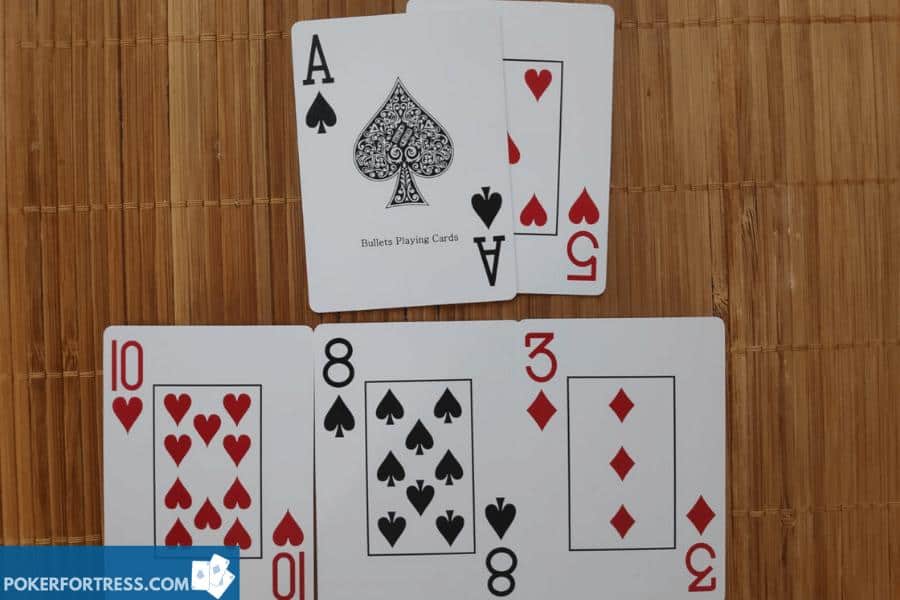 it is hard to continue when you miss the flop out of position with your weak ace high. The correct move, if faced with a bet, is to fold and avoid tough spots on later streets.
it is hard to continue when you miss the flop out of position with your weak ace high. The correct move, if faced with a bet, is to fold and avoid tough spots on later streets.
Suited aces are great to have in your cold calling range.
We can play with a lot of suited aces in position versus opens. Cold calling with Ax suited is much more appealing in multi-table tournaments (MTTs) then the cash game environment. Pots are not raked in MTTs, and the presence of ante gives you a lot better odds when calling.
Re-raising with an ace rag
Suited Ax is one of the prime 3bet bluff candidates. The power of 3beting suited ace X is that it has solid playability when called, and it blocks our opponent’s strong hands. For a more straightforward illustration of how to include Axs into your 3beting range, let’s look at a typical situation.
We sit OTB with 100 BB and face a CO raise. Our 3beting range should consist of all strong hands and some bluffs. As demonstrated in the picture below we can see that a lot of our bluffs come from suited Ax. Suited wheel aces are especially favored because of their ability to flop flushes, straights, and all kinds of draws. They also provide us with good board coverage* on low runouts.
(* how much of a board do our hole cards cover postflop. In this scenario on 459 we would have at least a gutshot straight draw, or maybe a pair)
Suited Ax, especially low ones, are also great 4bet bluff candidates but, of course, with much lower frequency since our value 4bet range is naturally narrower.
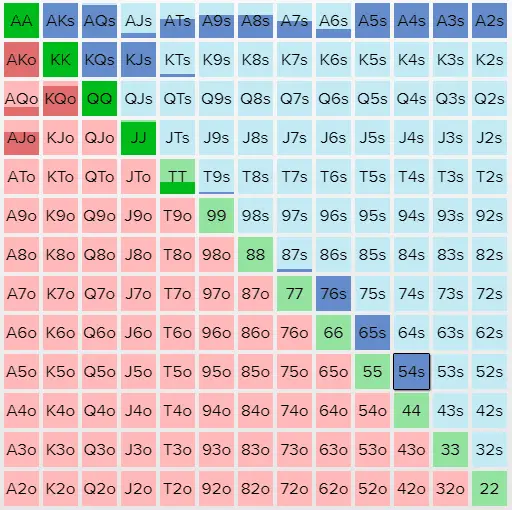 Some of the hands are not 3bet all the time, that’s why they are not fully filled with color.
Some of the hands are not 3bet all the time, that’s why they are not fully filled with color.
You can notice that in the range chart, not all frames are fully filled. That just means that we don’t 3bet them with 100% frequency. For example, in our scenario, with A9s, we 3bet 75% of the time while A6s only 25%.
Ace blocker
Ace blocker is a card that reduces some number of combos in our opponent’s range, either preflop or post-flop. Let’s see how the Ace blocker reduces the chances of our opponents having a strong hand.
As you can see in Table 3, having an ace blocker dramatically reduces the number of strong Ax combinations from our opponent’s range. When we hold an ace, it is 25% less likely that our opponent holds those strong aces. It’s half as likely that our opponent has AA when we hold Ax.
Preflop handReduction of combosAKfrom 16 to 12AKo, AQo, AJofrom 12 to 9AKs, AQs, AJsfrom 4 to 3AAfrom 6 to 3Table 3
Holding Ace blocker doesn’t just influence the hand preflop but also post-flop. With Ax, We are substantially reducing our opponent’s top value range. By holding an ace, we reduce the overall chances of our opponent holding a very strong Ax hand by 35%.
Our hand = A4sFlop = AT3rAK, AQ, AJfrom 12 to 8A3 or ATfrom 18 to 12AAfrom 3 to 1Overallfrom 57 to 37Table 4: A4s reduces the chances an opponent has hit a strong top pair by 35% on certain A high boards.
Postflop with an ace rag
With an ace-rag, most money gets torched post-flop. Players get married to their TPNK (top pair, no kicker) hands and are unwilling to let them go. In my poker career, I have seen countless times when players just station down TPNK without even much thought. This mistake gets especially punished in CG (cash games) since play is much deeper on average then MTTs.
With these kinds of medium-strength hands, you should play small pots not big.
Pot control
When flopping an ace with a weak kicker, your immediate thought should be pot control. That means that in most cases, you don’t want to inflate the pot with your weak to medium strength hands.
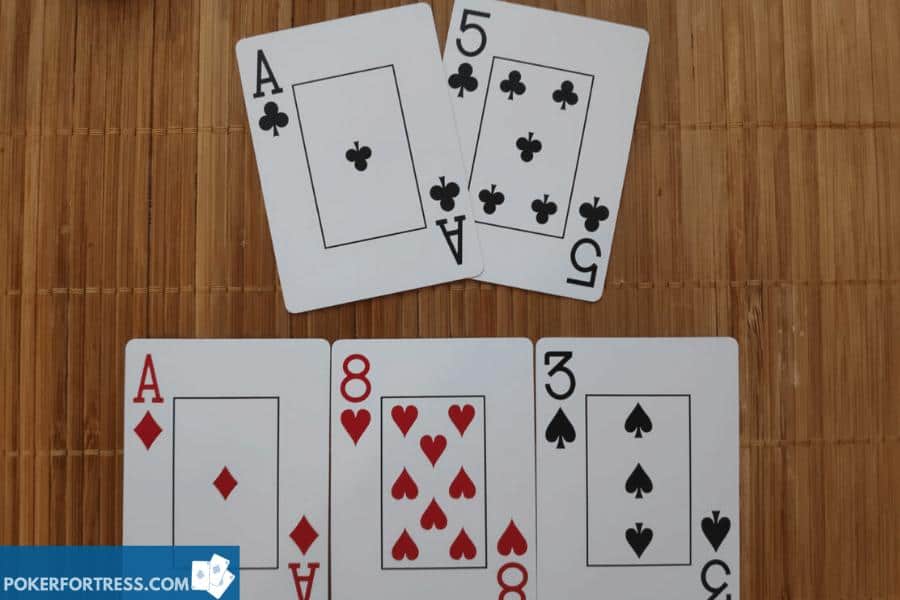
Let’s look at a widespread example where you raise CO with A5s and get a cold call from a good opponent OTB. The flop brings the A83r. Yes, we flopped top pair, but do we really want to start with betting and go for three streets. I don’t think so. Try to think of hands that can call our triple barrel that we beat unimproved. There are basically none. The villain will still have a lot of stronger aces, two pairs, and sets. Our hand is strong enough to get one, max two streets of value. When we check our top pair, we don’t just pot control but allow our opponent to start bluffing.
Bluff catching
Giving our opponents the opportunity to bluff when we have a bluff catcher is usually a very smart idea. Hands like TPNK fall in that category. Let’s look at an example hand. We raise A4s from CO, and BB defends. Flop is AT8r, and we decided to pot control and check back. Our opponent picks the initiative and starts betting on a 3x turn and 5x river. OTR (on the river), we face a decision to call or not with our TPNK. Since we block our opponent’s value range (mostly two pairs) and unblock his potential bluffs like KJ, QJ, J9, we have a pretty easy call versus most villains. It’s actually better to have A4 there then AJ because we really want to see that Jack in villains hand.
Semi bluffing
With suited aces, we will besides obvious nut flush draw flop a lot of gutshots and backdoor potential.
Backdoor straight and nut flush draws are great flop bets since we can put a lot of pressure when a favorable turn hits.
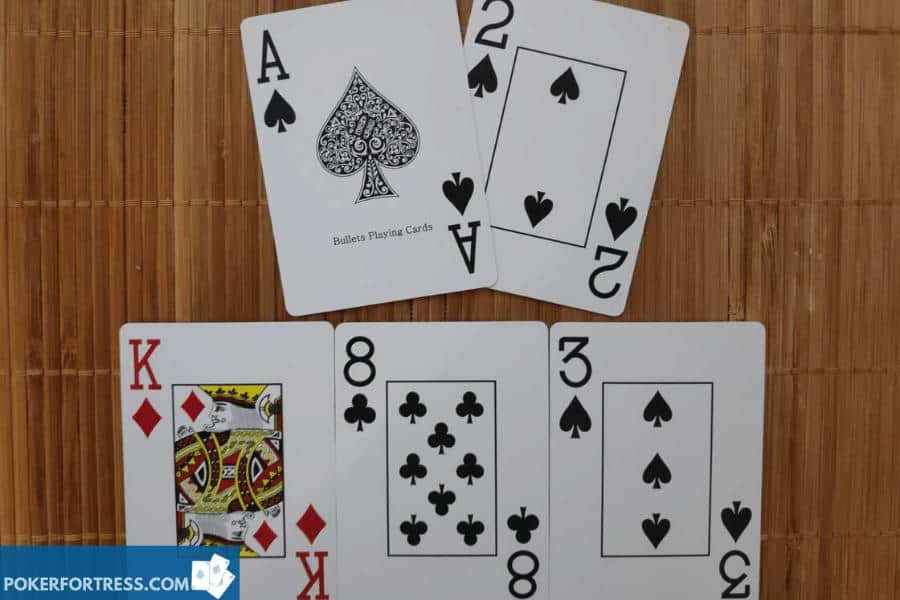 On the first glance it seems we have nothing. But we can get many draws on the turn. Good enough spot to cbet, as opponent folding is a great result too.
On the first glance it seems we have nothing. But we can get many draws on the turn. Good enough spot to cbet, as opponent folding is a great result too.
Imagine a scenario when you raise with A2ss from HJ and face BB defend. Flop brings Kd8c5s. At first glance, we flop nothing, but any spade gives us a flush draw and every 4 or 3 straight draws. That besides range advantage** gives us enough reasons to safely cbet.
**Situation where our range is stronger than our opponents.
Taking ace high to the showdown
Ace high is actually a legit hand that will win you some pots. Especially versus passive opponents, it’s sometimes a good idea to just take your ace high to a showdown. This mostly applies in spots where we expect villains never to fold a better hand, but there is still a reasonable chance that our ace high is good. An example of that would be checking down A7 on K8464. Realizing your equity with ace high is much easier in the position since you are last to act.
Power of Ace-rag with the short stack
A very common situation in MTTs is that you find yourself short stacking with 10 bbs. It’s basically do or die time. And believe it or not, ace-rag can be the answer to your problems. In the next example, you will find out next how strong ace-rag is in short stacked poker.
In our scenario*** hero has 10BB. We want to know what kind of ace-rag we can shove from various positions. With the help of a push/fold tool -Icmizer, we simulated a model for every position. In our model, we used a little bit tighter calling ranges that Nash equilibrium**** would suggest since the population in small stakes tournaments overfolds. That simply means that we can push wider since our all-ins have more fold equity. For easier illustration, I created a table with results.
Position0.2 bb +A2oA8oA5sA9sUTGAJ+;ATs+-0.49-0.310.060.18UTG+1AT+;A8s+-0.35-0.150.180.34UTG+2A8+,A3s+-0.230.010.320.49MP1A8+,A2s+0.010.250.520.73HJA4o+A2s+0.170.510.681.06COA2o+, A2s+0.420.870.921.4BTNA2o+, A2s+0.841.391.31.83SBA2o+, A2s+1.531.981.882.29Table 5: Many hands gain more than 0.2bb, while the worst aces lose a little.
You can see how many combinations there are that gain +0.2bb per hand. Because after all, we want to make some money in the long run and not take every high variance spot. It’s very easy to notice how our EV increases with the position. A5s barely makes any chips UTG while it absolutely prints OTB.
Axs become shove faster because of its suitedness increases all-in equity of the hand (Remember Table 2). Most of our EV when we shove weak aces come from our opponent’s folds. And since our ace blocks their calling range, they will fold more often. When we shove A9s UTG, we expect our opponents to fold around 55% of the time, gaining us humongous 2.3bb (blinds and antes). But in the other 45% when we get called, we still have around 35% equity.
The EV changes with the position because there are fewer opponents to go through, meaning that there is less likely that somebody will wake up with a hand. The reason why a hand as A8o from CO has such a high EV is because we expect to get called by a lot of worse hands like KQ, QJs, A4s, or flips (22-77).
*** MTT with ante
**** When players reach equilibrium they both play optimally vs. each other and gain nothing from deviating from equilibrium strategy
Conclusion
To master a play with ace rag takes a lot of experience and practice. Everybody at the beginning of their poker journey badly misplays a lot of ace-rag hands. So don’t worry too much if you mess up a hand, it happens to everybody. But you have to learn from your mistakes and overcome them. I learned the hard way, so you hopefully don’t have to. If nothing else, I want you to take away these main bullet points. Just following these guidelines can save and win you a lot of money in the long run.
Ace rags are mostly preflop steal hands: Steall with suited aces from ep and add off suited varieties from late position in 6max games
Play small pots: Pot control post-flop a lot
Great 3/4bet candidates: Specially suited wheel aces
Ace rag is solid hand when short stack: Learn push/fold strategies
Free trial



